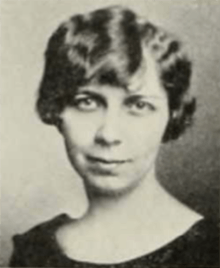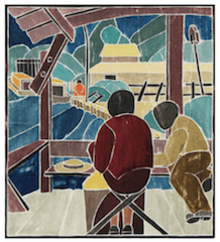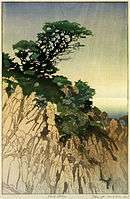Mabel Hewit
Mabel Hewit (1903–1984) was an American woodblock print artist, particularly the white-line style of the Provincetown Printers.
Mabel Hewit | |
|---|---|
 Mabel A. Hewitt, Ohio State University Yearbook, 1926 | |
| Born | 1903 |
| Died | 1984 |
| Nationality | American |
| Education | |
| Known for | White-line woodblock prints |
Early life and education
Mabel Amelia Hewit was born in 1903 in Conneaut, Ohio,[1][2] and was raised in Youngstown, where she graduated in 1921 from South High School. She attended Ohio State University, and graduated with a bachelor's degree in 1926.[2] While there, she was a member of the Pen and Brush Club, Panhellenic Council, Zeta Tau Alpha, and Kappa Phi. She also was on the staff of ‘’Phoenix’’.[3]
She then taught in Detroit and Youngstown's public schools. In 1932, she received her master's degree from the Teachers College, Columbia University.[2] While at Columbia, she took art classes from Blanche Lazzell, who created woodblock prints using the white-line technique, at her studio at Provincetown, Massachusetts. She also took art lessons at the Summer School of Painting at Saugatuck, Michigan over sixteen summers.[2]
Career
During the Great Depression, in 1934, she moved to Cleveland with her sister, Ednah Jurey, a weaver and certified public accountant, and lived there and then Parma for the rest of her life.[2] She had a studio in Cleveland.[4]

Hewit made prints of city and small-town life from that time. Using the white-line woodblock technique, she created prints of women sunbathing at the beach, The Ball Game (1934), factories, and neighbors with gable-roofed house that reflect her interest in modernism in the slightly abstract forms. Her works reflect influence of 19th-century Japanese ukiyo-e woodblock prints, her study with Lazzell, and French works, like that of Paul Gauguin and Maurice Denis. She said that she liked "block printing because it gives the family of moderate means an opportunity to have something of color and art in their homes."[2]
In 1946, she captured an outdoor scene of a couple playing chess in Summer Chess. She made Janitzio of an island of a Mexican lake in 1954 that "says 'early paradise' with extreme economy.[2] She also made prints on fabric. She made watercolor paintings, lithograph prints, enamels on metal, and ceramics.[1] Her enamel works, which were in the collection of the Cleveland Museum of Art, were exhibited in 1949.[4]
She died in 1984. An exhibit of her work was held in 2010 at the Cleveland Museum of Art,[2] with an accompanying book for the show, Midwest Modern: The Color Woodcuts of Mabel Hewit.[5]
References
- "Gallery Views of Midwest Modern: The Color Woodcuts of Mabel Hewit". Cleveland Museum of Art. Retrieved February 4, 2017.
- Steven Litt (July 12, 2010). "Mabel Hewit woodblock prints celebrated at Cleveland Museum of Art". Cleveland.com. Retrieved February 4, 2017.
- Ohio State University yearbook, U.S., School Yearbooks, 1880-2012 [database on-line]. Provo, UT, USA: Ancestry.com Operations, Inc., 1926
- "Artist to Lecture on Enamel Works". The Pantagraph. Bloomington, Indiana. November 9, 1949. p. 2. Retrieved February 4, 2017 – via newspapers.com.
- Jane Glaubinger (2010). Midwest Modern: The Color Woodcuts of Mabel Hewit. Cleveland Museum Of Art. ISBN 978-1-935294-01-6.
Further reading
- Peter Hastings Falk, ed. (1999). Who Was Who in American Art. 400 years of artists in America (Second ed.). Madison, Connecticut: Sound View Press.
- Blanche Lazzell; Barbara Stern Shapiro; Museum of Fine Arts, Boston (2002). From Paris to Provincetown: Blanche Lazzell and the color woodcut. MFA Publications, a division of the Museum of Fine Arts.
